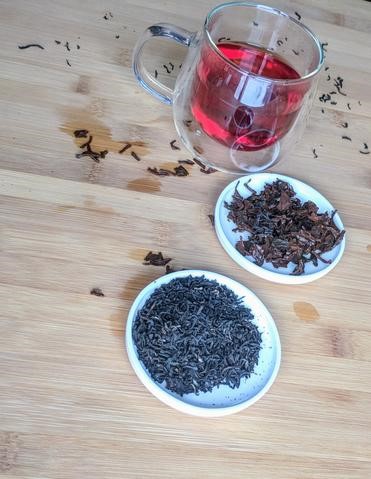
Tea has quite the history.
Emperor Shen Nong
One idea of how tea began was through Emperor Shen Nong in 2737BC. Apparently, he was boiling water; there was a breeze; it blew a few leaves into his pot of boiling water; the leaves brewed; a coloured liquor with a fragrant aroma formed. He tasted it. Like it. Tea was born. The tree the leaves came from were the first wild tea plant.
Bodhidharma
The second idea of how tea began is probably my favourite. Bodhidharma, the first patriarch of Zen, decided he was going to meditate for 9 years. So he sat facing the Shaolin Temple of China and meditated. Unfortunately, he nodded off. When he woke up from his 40 winks, he was so angry at himself he cut off his eyelids and threw them on the ground in a huff. It was from his eyelids that the firs tea bush grew. I wonder if he nodded off again?
However tea started, it started and slowly travelled around the world.
China
In China tea was mostly used for medicinal purposes until the Tang Dynasty, 618-907 AD. During the Tang Dynasty tea became more popular among artists such as painters, potters, poets. Lu Yu, 723-804 AD, was the first to create a treatise on tea called Cha Jing or Traditions of Tea, which standardized the methods of tea preparation.
Japan
The Japanese influence on tea first started in the 7th century. Tea was brought to Japan by the Buddhists monks however tea was not grown in Japan until the 15th century. Sen No Rikyu, 1522-1592, is the one who transformed tea into a religion, art form and philosophy. The art of tea in Japan can be seen through the Japanese tea ceremony. The Japanese tea ceremony displays politeness, charm, grace and perfect manners. The 2 main Japanese philosophies that stem from tea are,
Ichigo Ichi
Through tea, recognition is given that every human encounter is a singular occasion which can and will never recur again exactly.
Wabi
Finding beauty in the imperfect; appreciating the profound in all things in nature.
Europe
Tea eventually made its way to Europe by means of the Portuguese. The Portuguese had this advanced navy that allowed them to travel to China and be introduced to tea. In 1606 the first chests of tea arrived in Europe. Tea was shipped to Lisbon, Portugal. Dutch ships then brought tea to France and Holland the first countries to use tea. England was the last European country to be introduced to tea in 1652-1654. In 1618 tea was introduced to Russia. The trade route to Russia was 11 000 miles long; took 16 months to travel with up to 300 camels packed with cargo.
England
Now that tea had reached England, it became interesting. It seems Oliver Cromwell passed a law that European goods could only enter England on English ships. Tea became popular in England by King Charles II along with his wife Catherine de Breganza of Portugal. It seems Catherine’s dowry included prot cities in Bombay and drinking tea was popular among port nobility. Through this port, tea starting coming over to Europe and then England. The John Company was created by Elizabeth I as a trading company for Asian trade and created a monopoly everywhere except for Western Europe, western Africa and South America. Transporting the money to buy tea was a problem. China didn’t want to trade for England’s cotton. Why should they? China had silk. The John Company, however, grew opium in India, sold it for silver and traded that for the tea. The Chinese emperor tried to stop this trade with England as he saw that the Chinese were becoming addicted to opium. England fought for the “right to trade freely”. This was the beginning of the Opium Wars.
America
Eventually tea ended up in America. In 1650 the Dutch, who were actively involved in trade with the western world, along with the English, introduced tea to America. In time new Amsterdam, New York, consumed more tea than all of England! The French Indian War occurred after which the English put a tax on goods sent to American colonies as payment for helping fighting in the war. This led to the Boston Tea Party. In 1789 America entered into the tea trade with new faster, clipper ships. These ships out sailed the slower, heavier British ships. In 1843 clippers were everywhere including the tea and opium trade routes as demand for tea from China grew. The larger clipper ships were the tea clippers while the smaller clipper ships were the opium clippers. In time American developed a trusted trading partnership with China. America paid for the tea with gold which broke England’s monopoly on the tea trade with China.
Boston Tea Party
The Boston Tea Party was a protest again the British government, its Tea Act of 1773 and the East India Company monopoly. This protest was shown by Boston refusing to return 3 shiploads of taxed tea to Britain. Colonists in Boston boarded the ships and threw the tea overboard. The colonists wanted to be taxed by their government and not by the English. This lead to the American revolution.
Canada
In 1716 Canada received its first shipment of tea brought by the Hudson Bay Company. It took more than a year to arrive. Up until the late 1800s tea was sold lose by local merchants. Tea was sold straight out of the tea chests it arrived in. As a result, merchants were limited by whatever tea was imported and consumers couldn’t rely on any consistency from week to week.
Reference
Tea 101, Academy of Tea, URL: https://academyoftea.org/tea101/
- My first time making scones - March 26, 2024
- Disappointing Visits to the Ripon and Plateau Farmers Markets - September 30, 2023
- The Ultimate Guide to Frozen Raw Dog Food: Benefits, Selection, and Transition Tips - September 25, 2023











